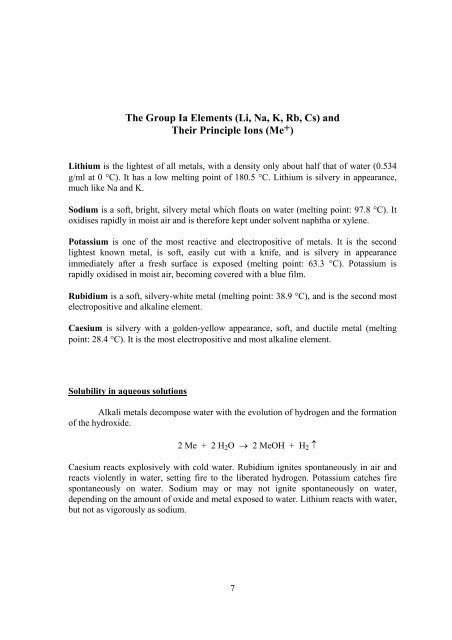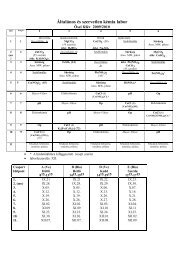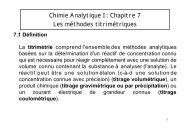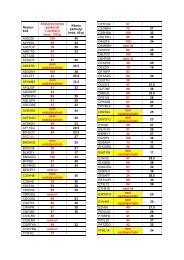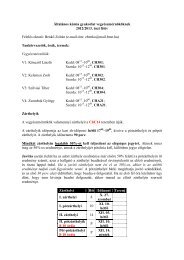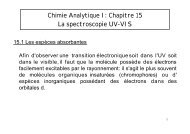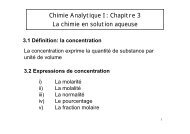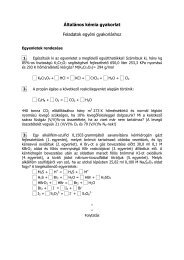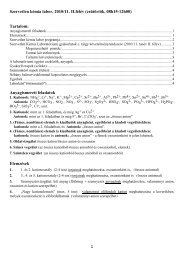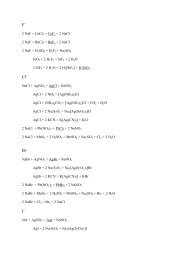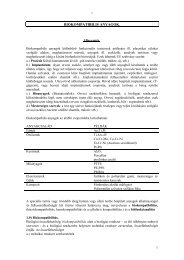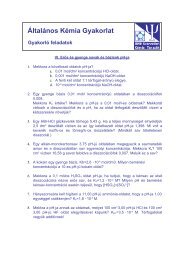The Group Ia Elements (Li, Na, K, Rb, Cs) and Their Principle Ions ...
The Group Ia Elements (Li, Na, K, Rb, Cs) and Their Principle Ions ...
The Group Ia Elements (Li, Na, K, Rb, Cs) and Their Principle Ions ...
You also want an ePaper? Increase the reach of your titles
YUMPU automatically turns print PDFs into web optimized ePapers that Google loves.
<strong>The</strong> <strong>Group</strong> <strong>Ia</strong> <strong>Elements</strong> (<strong>Li</strong>, <strong>Na</strong>, K, <strong>Rb</strong>, <strong>Cs</strong>) <strong>and</strong><strong>The</strong>ir <strong>Principle</strong> <strong>Ions</strong> (Me+)<strong>Li</strong>thium is the lightest of all metals, with a density only about half that of water (0.534g/ml at 0 °C). It has a low melting point of 180.5 °C. <strong>Li</strong>thium is silvery in appearance,much like <strong>Na</strong> <strong>and</strong> K.Sodium is a soft, bright, silvery metal which floats on water (melting point: 97.8 °C). Itoxidises rapidly in moist air <strong>and</strong> is therefore kept under solvent naphtha or xylene.Potassium is one of the most reactive <strong>and</strong> electropositive of metals. It is the secondlightest known metal, is soft, easily cut with a knife, <strong>and</strong> is silvery in appearanceimmediately after a fresh surface is exposed (melting point: 63.3 °C). Potassium israpidly oxidised in moist air, becoming covered with a blue film.Rubidium is a soft, silvery-white metal (melting point: 38.9 °C), <strong>and</strong> is the second mostelectropositive <strong>and</strong> alkaline element.Caesium is silvery with a golden-yellow appearance, soft, <strong>and</strong> ductile metal (meltingpoint: 28.4 °C). It is the most electropositive <strong>and</strong> most alkaline element.Solubility in aqueous solutionsAlkali metals decompose water with the evolution of hydrogen <strong>and</strong> the formationof the hydroxide.2 Me + 2 H 2 O → 2 MeOH + H 2 ↑Caesium reacts explosively with cold water. Rubidium ignites spontaneously in air <strong>and</strong>reacts violently in water, setting fire to the liberated hydrogen. Potassium catches firespontaneously on water. Sodium may or may not ignite spontaneously on water,depending on the amount of oxide <strong>and</strong> metal exposed to water. <strong>Li</strong>thium reacts with water,but not as vigorously as sodium.7
Flame testCompounds of alkali metals (<strong>and</strong> also some of the others, see later) are volatilizedin the non-luminous Bunsen flame <strong>and</strong> impart characteristic colours to the flame, whichcan be used to identify the metal.<strong>The</strong> physic-chemical process whichproduce the characteristic colour can besummarised as follows:1. salt is evaporated2. molecule decompose to itsconstituents; e.g. <strong>Na</strong>Cl → <strong>Na</strong> + Cl3. thermal excitation of valence shellelectron of the metal atom;<strong>Na</strong> → <strong>Na</strong>*4. instant relaxation of the excited stateswith ejecting photons:<strong>Na</strong>* → <strong>Na</strong> + hν6s5s4s3s2s1s6p5p4p3p2p5d4d3d4fIf the photons ejected are in the visibleregion, coloration of the flame isobserved.<strong>Na</strong> (3p3s)= 589 nm (yellow lightChlorides are among the most volatile compounds <strong>and</strong> readily decompose in the flame ofthe Bunsen burner, thus the best way to carry out the flame test is to prepare chlorides insitu by mixing the compound with a little concentrated hydrochloric acid before carryingout the tests.<strong>The</strong> procedure is as follows. Put a fewcrystals or a few drops of the solutioninto a porcelain crucible, addhydrochloric acid, <strong>and</strong> zinc chips. <strong>The</strong>hydrogen gas liberated in the reactionbetween zinc <strong>and</strong> hydrochloric acidcarries fine drops of the solution into theflame, where the latter are volatilised.<strong>The</strong> colours imparted to the flame:<strong>Li</strong>thium → carmine-redSodium → golden-yellowPotassium → violet (lilac)Rubidium → dark-redCaesium → blue8
Characteristic reactions of lithium ions<strong>The</strong> solubilities of lithium carbonate, <strong>Li</strong> 2 CO 3 , the phosphate, <strong>Li</strong> 3 PO 4 , <strong>and</strong> thefluoride, <strong>Li</strong>F, in water are little, definitely much less than the corresponding sodium <strong>and</strong>potassium salts, <strong>and</strong> in this respect lithium resembles the alkaline earth metals. All otherimportant inorganic lithium salts are soluble in water.For example: compound solubility ( g / 100 mlwater)at 18 °C: <strong>Li</strong>F<strong>Li</strong> 3 PO 40,270,0390 °C: <strong>Li</strong>Cl 63,7To study these reactions use a 1 M solution of lithium chloride.1. Sodium phosphate solution: partial precipitation of lithium phosphate, <strong>Li</strong> 3 PO 4 , inneutral solutions.3 <strong>Li</strong> + + PO 43− → <strong>Li</strong>3 PO 4 ↓Precipitation is almost complete in the presence of sodium hydroxide solution.2. Sodium carbonate solution: white precipitate of lithium carbonate fromconcentrated solutions:2 <strong>Li</strong> + + CO 32− → <strong>Li</strong>2 CO 3 ↓3. Ammonium carbonate solution: white precipitate of lithium carbonate fromconcentrated solutions.2 <strong>Li</strong> + + CO 32− → <strong>Li</strong>2 CO 3 ↓No precipitation occurs in the presence of high concentration of ammonium chloridesince the carbonate ion concentration is reduced to such an extent that the solubilityproduct of lithium carbonate is not exceeded:NH 4+ + CO32− ↔ NH3 + HCO 3−4. Ammonium fluoride solution: a white, gelatinous precipitate of lithium fluoride isslowly formed in ammoniacal solution.5. Flame test: carmine-red colour.<strong>Li</strong> + + F − → <strong>Li</strong>F ↓9
Sodium, <strong>Na</strong> +Almost all sodium salts are soluble in water. <strong>The</strong>re are, however, some specialreagents which a crystalline precipitate is formed with if it is added to a fairlyconcentrated solution of sodium salts.To study these reactions use a 1 M solution of sodium chloride.1. Uranyl magnesium acetate solution: yellow, crystalline precipitate of sodiummagnesium uranyl acetate <strong>Na</strong>Mg(UO 2 ) 3 (CH 3 COO) 9 .9H 2 O from concentratedsolutions:<strong>Na</strong> + + Mg 2+ + 3 UO 22+ + 9 CH3 COO − → <strong>Na</strong>Mg(UO 2 ) 3 (CH 3 COO) 92. Uranyl zinc acetate solution: yellow, crystalline precipitate of sodium zinc uranylacetate <strong>Na</strong>Zn(UO 2 ) 3 (CH 3 COO) 9 .9H 2 O :<strong>Na</strong> + + Zn 2+ + 3 UO 22+ + 9 CH3 COO − → <strong>Na</strong>Zn(UO 2 ) 3 (CH 3 COO) 93. Flame test: intense yellow colour.Potassium, K +Most of the potassium salts salts are soluble in water.To study the reactions which produce water insoluble or little soluble salts, use a1 M solution of potassium chloride. Remember, the sizes of K + <strong>and</strong> NH 4 + ions are almostidentical, thus their reactions in general are very similar.1. Perchloric acid solution (HClO 4 ): white crystalline precipitate of potassiumperchlorate KClO 4 from not too dilute solutions. You may use concentrated HClO 4solution. (This reaction is unaffected by the presence of ammonium salts.)K + + ClO 4− → KClO4 ↓2. Tartaric acid solution (or sodium hydrogen tartrate solution): white crystallineprecipitate of potassium hydrogen tartrate:K + + H 2 C 4 H 4 O 6 → KHC 4 H 4 O 6 ↓ + H +<strong>The</strong> solution should be buffered with sodium acetate. <strong>The</strong> precipitate is slightly soluble inwater (3.26 g/l). (Ammonium salts yield a similar precipitate.)10
3. Sodium hexanitritocobaltate(III) solution, <strong>Na</strong> 3 [Co(NO 2 ) 6 ]: yellow precipitate ofpotassium hexanitritocobaltate(III):3 K + + [Co(NO 2 ) 6 ] 3− → K 3 [Co(NO 2 ) 6 ] ↓<strong>The</strong> precipitate is insoluble in dilute acetic acid. In alkaline solutions a brown precipitateof cobalt(III) hydroxide is obtained. (Ammonium salts give a similar precipitate.)If larger amounts of sodium salts are present (e.g. reagent is added in excess) a mixed saltis formed:2 K + + <strong>Na</strong> + + [Co(NO 2 ) 6 ] 3− → K 2 <strong>Na</strong>[Co(NO 2 ) 6 ] ↓<strong>The</strong> test is more sensitive if sodium hexanitritocobaltate(III) <strong>and</strong> silver nitrate solutionsare added together to halogen free solutions; the compound K 2 Ag[Co(NO 2 ) 6 ] forms,which is less soluble in water than the corresponding salt, K 2 <strong>Na</strong>[Co(NO 2 ) 6 ].5. Flame test: violet colour.Summarise the solubility of common inorganic salts of <strong>Li</strong> + , <strong>Na</strong> + , <strong>and</strong> K + :CO 32−PO 43−F − Cl − NO 3−SO 42−<strong>Li</strong> +<strong>Na</strong> +K +11
<strong>The</strong> <strong>Group</strong> I<strong>Ia</strong> <strong>Elements</strong> (Be, Mg, Ca, Sr, Ba) <strong>and</strong><strong>The</strong>ir <strong>Principle</strong> <strong>Ions</strong> (Me 2 +)Beryllium is a steel grey, light but very hard, brittle metal, one of the lightest of allmetals, <strong>and</strong> has one of the highest melting points of the light metals (1278 °C). Berylliumobjects are oxidised on the surface, but the oxide layer protects the objects from furtheroxidisation, which is similar to that of aluminium. Beryllium resembles closelyaluminium in chemical properties; it also exhibits resemblances to the alkaline earthmetals.Magnesium is a light, silvery-white, malleable <strong>and</strong> ductile metal with a melting point of649 °C. Magnesium objects have a protective oxide layer on the surface, similarly to thatof beryllium <strong>and</strong> aluminium. It burns upon heating in air or oxygen with a brilliant whitelight, forming the oxide <strong>and</strong> some nitride.Calcium has a silvery colour, is rather soft, but definitely much harder than the alkalimetals (melting point: 839 °C). It is attacked by atmospheric oxygen <strong>and</strong> humidity, whencalcium oxide <strong>and</strong>/or calcium hydroxide is formed.Strontium is a silvery-white, malleable <strong>and</strong> ductile metal (melting point: 769 °C).Strontium is softer than calcium <strong>and</strong> decomposes water more vigorously. It should bekept under kerosene to prevent oxidation. Freshly cut strontium has a silvery appearance,but rapidly turns a yellowish colour with the formation of the oxideBarium is a silvery-white, soft, malleable <strong>and</strong> ductile metal (melting point: 725 °C). Itoxidises very easily <strong>and</strong> should be kept under petroleum to exclude air.Solubility in water <strong>and</strong> acidsBeryllium does not reacts with water at ordinary conditions.Magnesium is slowly decomposed by water at ordinary temperature, but at theboiling point of water the reaction proceeds rapidly:Mg + 2 H 2 O → Mg(OH) 2 ↓ + H 2 ↑Calcium, strontium, <strong>and</strong> barium decompose water at room temperature with theevolution of hydrogen <strong>and</strong> the formation of the hydroxide.Me + 2 H 2 O → Me 2+ + 2 OH − + H 2 ↑Be, Mg, Ca, Sr, <strong>and</strong> Ba dissolve readily in dilute acids (unless water insoluble saltforms):Me + 2 H + → Me 2+ + H 2 ↑Concentrated nitric acid renders beryllium passive (like aluminium).12
Characteristic reactions of magnesium ions, Mg 2+<strong>The</strong> magnesium oxide, hydroxide, carbonate, <strong>and</strong> phosphate are insoluble inwater; the other common inorganic salts are soluble.To study these reactions use a 0.1 M solution of magnesium chloride or sulphate.1. Ammonium carbonate solution: in the absence of other ammonium salts a whiteprecipitate of basic magnesium carbonate:5 Mg 2+ + 6 CO 32− + 7 H2 O → 4 MgCO 3 .Mg(OH) 2 .5 H 2 O ↓ + 2 HCO 3−In the presence of ammonium salts no precipitation occurs, because the followingequilibrium is shifted towards the formation of hydrogen carbonate ions (remember,magnesium hydrogen carbonate is soluble in water):NH 4+ + CO32− ↔ NH3 + HCO 3−2. Sodium carbonate solution: white, voluminous precipitate of basic magnesiumcarbonate:5 Mg 2+ + 6 CO 32− + 7 H2 O → 4 MgCO 3 .Mg(OH) 2 .5 H 2 O ↓ + 2 HCO 3−3. Ammonium hydroxide solution: partial precipitation of white, gelatinousmagnesium hydroxide, solubility product constant: K sp (25°C)= 5.61x10 −12 :Mg 2+ + 2 NH 3 + 2 H 2 O → Mg(OH) 2 ↓ + 2 NH 4+<strong>The</strong> precipitate is readily soluble in solutions of ammonium salts.4. Sodium hydroxide solution: white precipitate of magnesium hydroxide:Mg 2+ + 2 OH − → Mg(OH) 2 ↓5. Disodium hydrogen phosphate solution: a white flocculant precipitate ofmagnesium hydrogen phosphate is produced in neutral solutions:Mg 2+ + HPO 42− → MgHPO4 ↓White crystalline precipitate of magnesium ammonium phosphate MgNH 4 PO 4 .6H 2 O inthe presence of ammonium chloride (to prevent precipitation of magnesium hydroxide)<strong>and</strong> ammonia solutions:Mg 2+ + NH 3 + HPO 42− → MgNH4 PO 4 ↓<strong>The</strong> precipitate is soluble in acetic acid <strong>and</strong> in mineral acids.13
6. Titan yellow reagent <strong>and</strong> magneson reagent:Titan yellow <strong>and</strong> magneson (I <strong>and</strong> II)are water soluble dyestuffs. <strong>The</strong>y areabsorbed by magnesium hydroxideproducing a deep-red colour with titanyellow <strong>and</strong> a blue colour with magneson.Pour a little amount of the test solutioninto two test tubes, add 1-2 drops of thetitan yellow reagent to one test tube <strong>and</strong>1-2 drops of the magneson reagent to theother test tube. Render the solutions inboth test tubes alkaline with sodiumhydroxide solutions.O 2 N N N OHHOMagneson IO 2 N N N OHMagneson IICalcium, Ca 2+Calcium chloride <strong>and</strong> nitrate are readily soluble in water.Calcium oxide (similarly to strontium <strong>and</strong> barium oxides) readily reacts withwater producing heat <strong>and</strong> forming the hydroxide.Calcium sulphide (<strong>and</strong> also other alkaline earth sulphides) can be prepared only inthe dry; it hydrolyses in water forming hydrogen sulphide <strong>and</strong> hydroxide:2 CaS + 2 H 2 O → 2 Ca 2+ + 2 SH - + 2 OH -Calcium carbonate, sulphate, phosphate, <strong>and</strong> oxalate are insoluble in water.To study the reactions of Ca 2+ ions, use a 0.1 M solution of calcium chloride.1. Ammonium carbonate solution: white amorphous precipitate of calcium carbonate,solubility product constant: K sp (25°C)= 4.96x10 −9 , (the precipitate is soluble in acidseven in acetic acid):Ca 2+ + CO 32− → CaCO3 ↓2. Dilute sulphuric acid: white precipitate of calcium sulphate, solubility productconstant: K sp (25°C)= 7.10x10 −5 :Ca 2+ + SO 42− → CaSO4 ↓3. Ammonium oxalate solution: white precipitate of calcium oxalate, solubilityproduct constant: K sp (CaC 2 O 4 .H 2 O, 25°C)= 2.34x10 −9 (insoluble in acetic acid, butsoluble in mineral acids):Ca 2+ + (COO) 22− → Ca(COO)2 ↓14
4. Disodium hydrogen phosphate solution: white precipitate of calcium hydrogenphosphate is produced from neutral solutions:Ca 2+ + HPO 42− → CaHPO4 ↓5. Potassium hexacyanoferrate(II) solution: white precipitate of a mixed salt:Ca 2+ + 2 K + + [Fe(CN) 6 ] 4− → K 2 Ca[Fe(CN) 6 ] ↓In the presence of ammonium chloride the test is more sensitive. In this case potassium isreplaced by ammonium ions in the precipitate. <strong>The</strong> test can be used to distinguishcalcium from strontium; barium <strong>and</strong> magnesium ions however interfere.6. Flame test: yellowish-red colour to the Bunsen flame.Strontium, Sr 2+Strontium chloride <strong>and</strong> nitrate are readily soluble in water.Strontium carbonate, sulphate, phosphate, <strong>and</strong> oxalate are insoluble in water.To study the reactions of Sr 2+ ions, use a 0.1 M solution of strontium chloride orstrontium nitrate.1. Ammonium carbonate solution: white precipitate of strontium carbonate,K sp (SrCO 3 , 25°C)= 5.60x10 −10 (the precipitate is soluble in acids even in acetic acid):Sr 2+ + CO 32− → SrCO3 ↓2. Dilute sulphuric acid: white precipitate of strontium sulphate, K sp (SrSO 4 , 25°C)=3.44x10 −7 :Sr 2+ + SO 42− → SrSO4 ↓3. Saturated calcium sulphate solution: white precipitate of strontium sulphate,formed slowly in the cold, but more rapidly on boiling.Sr 2+ + SO 42− → SrSO4 ↓4. Ammonium oxalate solution: white precipitate of strontium oxalate:Sr 2+ + (COO) 22− → Sr(COO)2 ↓15
5. Disodium hydrogen phosphate solution: white precipitate of strontium hydrogenphosphate is produced from neutral solutions:Sr 2+ + HPO 42− → SrHPO4 ↓6. Potassium chromate solution: yellow precipitate of strontium chromate:Sr 2+ + CrO 42− → SrCrO4 ↓<strong>The</strong> precipitate is appreciably soluble in water, thus no precipitate occurs in dilutesolutions of strontium ions.<strong>The</strong> precipitate is soluble in acetic acid <strong>and</strong> in mineral acids.<strong>The</strong> addition of acid to potassium chromate solution causes the yellow colour ofthe solution to change to reddish-orange, owing to the formation of dichromate. <strong>The</strong>addition of acetic acid or mineral acid to the potassium chromate solution lowers theCrO 4 2− ion concentration sufficiently to prevent the precipitation of SrCrO 4 .<strong>The</strong> equilibria are the following:H 2 CrO 4 ↔ HCrO 4− + H+HCrO 4− ↔ CrO42− + H+[CrO 42- ] (mol/l)0.100.080.06c= 0.1 M (K 2CrO 4)2 HCrO 4− ↔ H2 O + Cr 2 O 72−0.040.02HCr 2 O 7− ↔ Cr2 O 72− + H+0.000 2 4 6 8 10pH7. Flame test: crimson-red colour to the Bunsen flame.Barium, Ba 2+Barium chloride <strong>and</strong> nitrate are readily soluble in water.Barium carbonate, sulphate, phosphate, <strong>and</strong> oxalate are insoluble in water.To study the reactions of Ba 2+ ions, use a 0.1 M solution of barium chloride orbarium nitrate.1. Ammonium carbonate solution: white precipitate of barium carbonate, K sp (BaCO 3 ,25°C)= 2.58x10 −9 (the precipitate is soluble in acids even in acetic acid):Ba 2+ + CO 32− → BaCO3 ↓16
2. Dilute sulphuric acid: white, finely divided precipitate of barium sulphate,K sp (BaSO 4 , 25°C)= 1.07x10 −10 :Ba 2+ + SO 42− → BaSO4 ↓3. Saturated calcium sulphate solution: immediate white precipitate of bariumsulphate.4. Saturated strontium sulphate solution: white precipitate of barium sulphate.5. Ammonium oxalate solution: white precipitate of barium oxalate (readily dissolvedby hot dilute acetic acid <strong>and</strong> by mineral acids):Ba 2+ + (COO) 22− → Ba(COO)2 ↓6. Disodium hydrogen phosphate solution: white precipitate of barium hydrogenphosphate is produced from neutral solutions:Ba 2+ + HPO 42− → BaHPO4 ↓6. Potassium chromate solution: yellow precipitate of barium chromate, practicallyinsoluble in water, K sp (BaCrO 4 , 25°C)= 1.17x10 −10 :Ba 2+ + CrO 42− → BaCrO4 ↓<strong>The</strong> precipitate is insoluble in dilute acetic acid (distinction from strontium), but solublein mineral acids.7. Flame test: yellowish-green colour to the Bunsen flame.Compare the solubility product constants of CaSO 4 , SrSO 4 , <strong>and</strong> BaSO 4 , <strong>and</strong>calculate the sulphate ion concentration in saturated solutions.CaSO 4 SrSO 4 SrSO 4solubility product 7.10x10 −5 3.44x10 −7 1.07x10 −10constant: K spSO 42−concentration17
Summarise the reactions of Mg 2+ , Ca 2+ , Sr 2+ , <strong>and</strong> Ba 2+ ions:Mg 2+ Ca 2+ Sr 2+ Ba 2+NH 3 soln.<strong>Na</strong>OH<strong>Na</strong> 2 CO 3(NH 4 ) 2 CO 3+ NH 4 Cl(NH 4 ) 2 CO 3<strong>Na</strong> 2 HPO 4(NH 4 ) 2 (COO) 2add hot acetic acidto the precipitateK 2 CrO 4neutral soln.add acetic acid tothe precipitate1. add acetic acidto the precipitate2. add mineral acidto the prec.dilute H 2 SO 4satd. CaSO 4 soln.satd. SrSO 4 soln.Flame test18
<strong>The</strong> <strong>Group</strong> II<strong>Ia</strong> <strong>Elements</strong>: Boron <strong>and</strong> Aluminium, <strong>and</strong><strong>The</strong>ir <strong>Principle</strong> <strong>Ions</strong> (B(OH)4 − <strong>and</strong> Al3+)Boron has properties that place it on the borderline between metals <strong>and</strong> nonmetals, butchemically it must be classed as a nonmetal. Boron is a hard, steel-grey solid with a highmelting point of 2079 °C. Crystalline boron is extremely inert chemically.Aluminium. Pure aluminium is a silvery-white metal (melting point (m.p.): 660.4 °C). Itis light, malleable <strong>and</strong> ductile, can easily be formed, machined, or cast, has a highthermal conductivity, <strong>and</strong> has an excellent corrosion resistance. <strong>The</strong> aluminium powder isgrey. Exposed to air, aluminium objects are oxidised on the surface, but the oxide layerprotects the objects from further oxidisation.Solubility in aqueous acids <strong>and</strong> alkaliBoron is unaffected by nonoxidising acids (e.g. boiling HCl or HF).It is only slowly oxidised by hot, concentrated nitric acid, <strong>and</strong> also only slowly attackedby other hot concentrated oxidising agents (e.g. aqua regia, or a mixture of concentratednitric acid <strong>and</strong> hydrogen fluoride).Boron is soluble in alkali with the evolution of hydrogen gas.B + HNO 3 + H 2 O → H 3 BO 3 + NO ↑2 B + 2 HNO 3 + 4 H 2 F 2 → 2 H[BF 4 ] + 2 NO ↑ + 4 H 2 O2 B + 2 <strong>Na</strong>OH + 6 H 2 O → 2 <strong>Na</strong> + + 2 B(OH) 4− + 3 H2 ↑Aluminium is soluble in dilute or concentrated hydrochloric acid with theliberation of hydrogen:2 Al + 6 HCl → 2 Al 3+ + 6 Cl - + 3 H 2 ↑Dilute sulphuric acid dissolves the metal with the liberation of hydrogen <strong>and</strong>concentrated sulphuric acid with the liberation of sulphur dioxide:2 Al + 3 H 2 SO 4 → 2 Al 3+ + 3 SO 42− + 3 H 2 ↑2 Al + 6 H 2 SO 4 → 2 Al 3+ + 3 SO 42− + 3 SO 2 ↑ + 6 H 2 OConcentrated nitric acid renders aluminium passive, but dilute nitric acid dissolves themetal:Al + 4 HNO 3 → Al 3+ + 3 NO 3− + NO ↑ + 2 H 2 OAluminium is soluble in alkali hydroxides when a solution of tetrahydroxoaluminate isformed:2 Al + 2 OH - + 6 H 2 O → 2 [Al(OH) 4 ] − + 3 H 2 ↑19
Reducing power of aluminiumAluminium is a very reactive metal, in particular towards electronegativepartners, but this extreme reactivity can only be observed when the stable oxide layer atthe metal surface is destroyed or the metal is in a finely divided form.1. Termite reaction: no reaction occurs between iron(III) oxide <strong>and</strong> aluminium powderat room temperature, but an exothermic, violent reaction takes place when it is initiatedby a thermal ignition mixture.Fe 2 O 3 + 2 Al → Al 2 O 3 + 2 Fe<strong>The</strong> reaction is extremely violent <strong>and</strong> is accompanied by the formation of a large amountof sparks.2. Reaction with iodine: add only one drop of water to a mixture of fine aluminiumpowder <strong>and</strong> powdered iodine.2 Al + 3 I 2 → Al 2 I 6<strong>The</strong> reaction is induced by water, the heat which is set free at the beginning of thereaction sufficing to convert the whole mixture to dialuminium hexaiodide <strong>and</strong> tosublime the excess iodine.Aluminium(III) ions, Al3+Solubility: aluminium chloride, bromide, iodide, nitrate, <strong>and</strong> sulphate are solublein water.Aluminium fluoride is hardly soluble in water. Aluminium oxide, hydroxide,phosphate, <strong>and</strong> carbonate are practically insoluble in water.For example: compound solubility ( g / 100 mlwater)at 15 °C AlCl 369,925 °C AlF 30,559α-Al 2 O 0,0000983-----AlPO 4Aluminium sulphide can be prepared in the dry state only, in aqueous solutions ithydrolyses <strong>and</strong> aluminium hydroxide is formed.Use a 0.1 M solution of aluminium chloride or sulphate to study the reactions ofaluminium(III) ions.20
1. Ammonium sulphide solution: a white precipitate of aluminium hydroxide.2 Al 3+ + 3 S 2− + 6 H 2 O → 2 Al(OH) 3 ↓ + 3 H 2 S ↑2. Sodium hydroxide solution: white precipitate of aluminium hydroxide. <strong>The</strong>precipitate dissolves in excess reagent, when tetrahydroxoaluminate ions are formed.Al 3+ + 3 OH − → Al(OH) 3 ↓Al(OH) 3 ↓ + OH − → [Al(OH) 4 ] −<strong>The</strong> reaction is a reversible one, <strong>and</strong> any reagent which will reduce the OH - ionconcentration sufficiently should cause the reaction to proceed from right to left.3. Ammonia solution: white gelatinous precipitate of aluminium hydroxide. <strong>The</strong>precipitate is only slightly soluble in excess of the reagent, the solubility is decreased inthe presence of ammonium salts.Al 3+ + 3 NH 3 + 3 H 2 O → Al(OH) 3 ↓ + 3 NH 4+4. Sodium phosphate solution: white gelatinous precipitate of aluminium phosphate,solubility product constant: K sp (AlPO 4 , 25°C)= 9.83x10 −21 :Al 3+ + HPO 42− → AlPO 4 ↓ + H +Strong acids <strong>and</strong> also sodium hydroxide dissolve the precipitate.5. Sodium acetate solution: no precipitate is obtained in cold, neutral solutions, but onboiling with excess reagent, a voluminous precipitate of basic aluminium acetate isformed:Al 3+ + 3 CH 3 COO - + 2 H 2 O → Al(OH) 2 CH 3 COO ↓ + 2 CH 3 COOH6. Sodium alizarin sulphonate (Alizarin-S) reagent:red precipitate in ammoniacal solution, which isfairly stable to dilute acetic acid.Add to the solution of Al 3+ ions, dilute ammoniasolution <strong>and</strong> 2-3 drops of the solution of the reagent, <strong>and</strong>then acidify it with acetic acid.OCCOOHOHSO <strong>Na</strong> 3Alizarin-S7. Morin reagent: add little solid sodium acetate <strong>and</strong> 1-2 drops of the reagent to the solution of Al 3+ ions.Investigate the characteristic green fluorescence of thesolution in UV light.HOOHHOOOHOOHMorin21
Oxides of Boron <strong>and</strong> AluminiumB 2 O 3B 2 O 3 is a white , hygroscopic solid.It is acidic, reacting with water to giveboric acid, B(OH) 3 .Al 2 O 3α−Al 2 O 3 is very hard <strong>and</strong> resistant tohydration <strong>and</strong> attack by acids.γ−Al 2 O 3 readily takes up water <strong>and</strong>dissolves in acids.Boric acid <strong>and</strong> borate ions in aqueous solutionBoric acid, H 3 BO 3 or B(OH) 3 , is a very weak <strong>and</strong> exclusively monobasic acid thatacts not as a proton donor, but as a Lewis acid, accepting OH − :B(OH) 3 + H 2 O ↔ B(OH) 4− + H+K S = 6x10 −10In aqueous, concentrated borate solutions polymeric ions are also present, due to thepolymerisation between B(OH) 3 <strong>and</strong> B(OH) 4− , the most important ions for example:4 B(OH) 3 + B(OH) 4− ↔ B5 O 6 (OH) 4− + 6 H2 O2 B(OH) 3 + B(OH) 4− ↔ B3 O 3 (OH) 4− + 3 H2 O2 B(OH) 3 + 2 B(OH) 4− ↔ B4 O 5 (OH) 42− + 5 H2 OIn acidic solution (pH12) B(OH) 4−ions exist exclusively, <strong>and</strong> at medium pH (4
<strong>The</strong> soluble salts are hydrolysed in solution, owing to the weakness of boric acid, <strong>and</strong>therefore react alkaline:BO 33− + 3 H 2 O ↔ H 3 BO 3 + 3 OH −B 4 O 72− + 7 H 2 O ↔ 4 H 3 BO 3 + 2 OH −BO 2− + 2 H 2 O ↔ H 3 BO 3 + OH −To study the reactions of borates use a 0.1 M solution of sodium tetraborate(sodium pyroborate, borax) <strong>Na</strong> 2 B 4 O 7 .10H 2 O.1. Barium chloride solution: white precipitate of barium metaborate from fairlyconcentrated solutions:B 4 O 72− + 2 Ba 2+ + H 2 O → 2 Ba(BO 2 ) 2 ↓ + 2 H +<strong>The</strong> precipitate is soluble in excess reagent, in dilute acids, <strong>and</strong> in solutions ofammonium salts.2. Silver nitrate solution: white precipitate of silver metaborate from fairly concentratedsolution:B 4 O 72− + 4 Ag + + H 2 O → 4 AgBO 2 ↓ + 2 H +<strong>The</strong> precipitate is soluble in both dilute ammonia solution <strong>and</strong> in acetic acid. On boilingthe precipitate with water, it is completely hydrolysed <strong>and</strong> a brown precipitate of silveroxide is obtained.AgBO 2 ↓ + 2 NH 3 + 2 H 2 O → [Ag(NH 3 ) 2 ] + + B(OH) 4−AgBO 2 ↓ + H + + H 2 O → Ag + + H 3 BO 32 AgBO 2 ↓ + 3 H 2 O → Ag 2 O + 2 H 3 BO 33. Hydrochloric acid: there is no visible change with dilute hydrochloric acid, but ifconcentrated hydrochloric acid is added to a concentrated solution of borax, boric acid isprecipitated:B 4 O 72− + 2 HCl + 5 H 2 O → 4 H 3 BO 3 ↓ + 2 Cl −4. Concentrated sulphuric acid <strong>and</strong> alcohol (flame test)If a little borax is mixed with 1ml concentrated sulphuric acid <strong>and</strong> 5ml methanol in a small porcelainbasin, <strong>and</strong> the alcohol ignited, thelatter will burn with a green-edgedflame due to the formation of methylborate B(OCH 3 ) 3 :B 4 O 72- + H 2 SO 4 + 5 H 2 O → 4 H 3 BO 3 + SO 42-H 3 BO 3 + 3 CH 3 OH → B(OCH 3 ) 3 ↑ + 3 H 2 O23
<strong>The</strong> <strong>Group</strong> IVa <strong>Elements</strong> (C, Si, Ge, Sn, Pb) <strong>and</strong><strong>The</strong>ir <strong>Principle</strong> <strong>Ions</strong>Carbon has three allotropic forms: diamond, graphite, <strong>and</strong> fullerenes.Diamond is the hardest solid known. It has a high density <strong>and</strong> the highest melting point (∼4000 °C) of any element. <strong>The</strong> chemical reactivity of diamond is much lower than that ofcarbon in the form of macrocrystalline graphite or the various amorphous forms.Diamond can be made to burn in air by heating it to 600 to 800 °C.Graphite has a layer structure <strong>and</strong> the forces between layers are relatively slight. Thus theobserved softness <strong>and</strong> particularly the lubricity of graphite can be attributed to the easyslippage of these layers over one another.Fullerenes belongs to the family of carbon-cage molecules, discovered during the lasttwo decades of the XXth century, of which C 60 <strong>and</strong> C 70 are the most known members.Both C 60 <strong>and</strong> C 70 are highly coloured crystalline solids that are sparingly soluble incommon organic solvents.Silicon has a solid structure which is isostructural with diamond. Crystalline silicon hasa metallic lustre <strong>and</strong> greyish colour. Melting point (m.p.): 1410 °C.Germanium is isostructural with diamond. It is a grey-white metalloid, <strong>and</strong> in its purestate is crystalline <strong>and</strong> brittle, retaining its lustre in air at room temperature. (m.p.: 937.4°C)Tin has two crystalline modifications: α-tin or grey tin, <strong>and</strong> β or white tin (metallicform). α-tin has the diamond structure.Tin (β-form) is a silver-white metal which is malleable <strong>and</strong> ductile at ordinarytemperatures, but at low temperatures (below 13.2 °C) it becomes brittle due totransformation into the α allotropic modification. Tin melts at 232 °C.Lead exists only in a metallic form. It is a bluish-grey metal with a high density, is verysoft, highly malleable, <strong>and</strong> ductile. Melting point: 327.5 °C. Lead is very resistant tocorrosion.Solubility of group IVa elements in aqueous acids <strong>and</strong> alkaliCarbon is very unreactive at normal conditions, but the reactivity of IVa groupelements is increasing down the group, from the carbon toward the lead.Carbon is not soluble in aqueous acids or alkalis.Silicon is rather unreactive. It is not attacked by acids except the mixture of HF<strong>and</strong> HNO 3 ; presumably the stability of SiF 62- provides the driving force here. Silicon issoluble in alkalis giving solutions of silicates.3 Si + 18 HF + 4 HNO 3 → 3 H 2 SiF 6 + 4 NO + 8 H 2 OSi + 2 KOH + H 2 O → K 2 SiO 3 + 2 H 224
Germanium is somewhat more reactive than silicon, <strong>and</strong> dissolves in concentratedH 2 SO 4 <strong>and</strong> HNO 3 , when GeO 2 .xH 2 O is formed. It is not attacked by alkalis <strong>and</strong> nonoxidising acids, soluble, however, in alkalis containing hydrogen peroxide.3 Ge + 4 HNO 3 + (x-2) H 2 O → 3 GeO 2 .xH 2 O ↓ + 4 NO ↑Tin <strong>and</strong> lead dissolve in several acids. Tin is attacked slowly by cold alkali,rapidly by hot, lead only by hot, to form stannates <strong>and</strong> plumbites.Sn + 2 <strong>Na</strong>OH + 2 H 2 O → <strong>Na</strong> 2 [Sn(OH) 4 ] + H 2 ↑Tin dissolves slowly in dilute hydrochloric acid <strong>and</strong> sulphuric acid with theformation of tin(II) salts:Sn + 2 H + → Sn 2+ + H 2 ↑Dilute nitric acid dissolves tin slowly without the evolution of any gas, tin(II) <strong>and</strong>ammonium ions being formed:4 Sn + 10 H + + NO 3− → 4 Sn 2+ + NH 4+ + 3 H 2 OIn hot, concentrated sulphuric acid <strong>and</strong> in aqua regia tin(IV) ions are formed atdissolution:Sn + 4 H 2 SO 4 → Sn 4+ + 2 SO 42− + 2 SO 2 ↑ + 4 H 2 O3 Sn + 4 HNO 3 + 12 HCl → 3 Sn 4+ + 12 Cl − + 4 NO ↑ + 8 H 2 OTin reacts vigorously with concentrated nitric acid, <strong>and</strong> a white solid, usually formulatedas hydrated tin(IV) oxide SnO 2 .xH 2 O <strong>and</strong> also known as metastannic acid, is produced:3 Sn + 4 HNO 3 + (x-2) H 2 O → 3 SnO 2 .xH 2 O ↓ + 4 NO ↑Lead readily dissolves in medium concentrated (8M) nitric acid with theformation of nitrogen oxide. <strong>The</strong> colourless nitrogen oxide gas, when mixed with air, isoxidised to red nitrogen dioxide:3 Pb + 8 HNO 3 → 3 Pb 2+ + 6 NO 3- + 2 NO ↑ + 4 H 2 O2 NO ↑ (colourless) + O 2 ↑ → NO 2 ↑ (reddish-brown)With concentrated nitric acid a protective film of lead nitrate is formed on the surface ofthe metal <strong>and</strong> prevents further dissolution.Dilute hydrochloric or sulphuric acid have little effect owing to the formation of aprotective film of insoluble lead chloride or sulphate on the surface.25
<strong>Principle</strong> oxides of IVa group elementsC Si Ge Sn PbCO, CO 2colourless gasesSiO 2white solidGeO 2white solidSnO red(β) *SnO 2 white* white SnO.xH 2 O <strong>and</strong> white PbO.xH 2 O precipitates from aqueous solutionsPbO yellow (red) *PbO 2 blackOnly CO 2 is soluble in water; the solubility strongly depends on the pressure <strong>and</strong>temperature. (1 litre water dissolves 0.9 litre of CO 2 of 1 atm pressure at 20 °C.)SiO 2 <strong>and</strong> GeO 2 are hardly soluble in water; e.g. the solubility of GeO 2 is 0.4 g in 100 gwater at 20 °C.SnO 2 <strong>and</strong> PbO 2 are insoluble in water.CO 2 is acidic, <strong>and</strong> the acidic character of oxides of the IVa group elements decreasesform the carbon dioxide toward the lead oxide. Carbon, silicon, <strong>and</strong> germanium oxidesare acidic, tin oxides are amphoteric, <strong>and</strong> lead oxide has also some basic character.CO 2 , SiO 2 , <strong>and</strong> GeO 2 are not soluble in acids, but soluble in alkalis giving carbonates,silicates, <strong>and</strong> germanates, respectively. Silicate <strong>and</strong> germanate anions are polymeric.SnO 2 is not soluble in acids <strong>and</strong> alkalis, <strong>and</strong> PbO 2 is only little soluble in acids.SnO is soluble in acids <strong>and</strong> alkalis, forming tin(II) salts or stannates.PbO is soluble in acids, forming lead(II) salts.Lead(IV) oxide, PbO 2 , is a strong oxidising agent (Pb 2+ / PbO 2 = +1.455 V), thus itliberates chlorine by boiling with concentrated hydrochloric acid:PbO 2 + 4 HCl → PbCl 2 + 2 H 2 O + Cl 2 ↑Principal ions of IVa group elements <strong>and</strong> their characteristic reactionsC Si Ge Sn PbCO 32− SiO 32− * GeO 32− * Sn 2+ Pb 2+HCO 3−Sn 4+* Does not exist in this form in aqueous solution.26
Carbonates, CO3 2−All normal carbonates, with the exception of those of the alkali metals <strong>and</strong> ofammonium, are insoluble in water.<strong>The</strong> hydrogen carbonates (or bicarbonates) of the alkali metals are soluble inwater, but are less soluble than the corresponding normal carbonates.<strong>The</strong> hydrogen carbonates of calcium, strontium , barium, magnesium, <strong>and</strong> possibly ofiron exist in aqueous solution; they are formed bye the action of excess carbonic acidupon the normal carbonates either in aqueous solution or suspension:CaCO 3 ↓ + H 2 O + CO 2 → Ca 2+ + 2 HCO 3−Hydrogen carbonates are decomposed to carbonates on boiling the solution.<strong>The</strong> following equilibria exists in aqueous solution:CO 2 + 3 H 2 O ↔ H 2 CO 3 + 2 H 2 O ↔ H 3 O + + HCO 3- + H 2 O ↔ 2 H 3 O + + CO 32-In acid solutions the equilibria shifted towards the left, while in alkaline medium they areshifted towards the right.To study the reactions of carbonates, use a 0.5 M solution of sodium carbonate,<strong>Na</strong> 2 CO 3 .10H 2 O.1. Dilute hydrochloric acid: decomposition with the evolution of carbon dioxide:CO 32- + 2 H + → CO 2 ↑ + H 2 Othe gas can be identified by its property ofrendering lime water or baryta water turbid:CO 2 + Ca 2+ + 2 OH - → CaCO 3 ↓ + H 2 OCO 2 + Ba 2+ + 2 OH - → BaCO 3 ↓ + H 2 OAny acid which is stronger than carbonic acidwill displace it, especially on warming. Thuseven acetic acid will decompose carbonates; theweak boric acid <strong>and</strong> hydrocyanic acid will not.2. Barium chloride (or calcium chloride) solution: white precipitate of barium (orcalcium) carbonate:CO 32- + Ca 2+ → CaCO 3 ↓CO 32- + Ba 2+ → BaCO 3 ↓Only normal carbonates react; hydrogen carbonates do not. <strong>The</strong> precipitate is soluble inmineral acids <strong>and</strong> carbonic acid.27
3. Silver nitrate solution: white precipitate of silver carbonate, solubility productconstant K sp (Ag 2 CO 3 , 25 °C)= 8.45x10 −12 :CO 32- + 2 Ag + → Ag 2 CO 3 ↓<strong>The</strong> precipitate is soluble in nitric acid <strong>and</strong> in ammonia. <strong>The</strong> precipitate becomes yellowor brown upon addition of excess reagent owing to the formation of silver oxide; thesame happens if the mixture is boiled:Ag 2 CO 3 ↓ → Ag 2 O ↓ + CO 2Hydrogen carbonates, HCO3 −Most of the reactions of hydrogen carbonates are similar to those of carbonates.<strong>The</strong> tests described here are suitable to distinguish hydrogen carbonates from carbonates.To study the reactions of hydrogen carbonates, use a freshly prepared 0.5 M solution ofsodium hydrogen carbonate, <strong>Na</strong>HCO 3 .1. Boiling. When boiling, hydrogen carbonates decompose:2 HCO 3- → CO 32- + H 2 O + CO 2 ↑carbon dioxide, formed in this way, can be identified with lime water or baryta water.2. Magnesium sulphate. Adding magnesium sulphate to a cold solution of hydrogencarbonate no precipitation occurs, while a white precipitate of magnesium carbonate isformed with normal carbonates.Heating the mixture, a white precipitate of magnesium carbonate is formed:Mg 2+ + 2 HCO 3- → MgCO 3 + H 2 O + CO 2 ↑carbon dioxide, formed in this way, can be identified with lime water or baryta water.3. Mercury(II) chloride. No precipitate is formed with hydrogen carbonate ions, whilein a solution of normal carbonates a reddish-brown precipitate of basic mercury(II)carbonate (3HgO.HgCO 3 = Hg 4 O 3 CO 3 ) is formed:CO 32- + 4 Hg 2+ 3 H 2 O → Hg 4 O 3 CO 3 ↓ + 6 H +the excess of carbonate acts as a buffer, reacting with the hydrogen ions formed in thereaction.28
4. Solid test On heating some solid alkali hydrogen carbonate in a dry test tube carbondioxide is evolved:2 <strong>Na</strong>HCO 3 → <strong>Na</strong> 2 CO 3 + H 2 O + CO 2 ↑<strong>The</strong> gas can be identified with lime water or baryta water.Silicates, SiO3 2−<strong>The</strong> silicic acids may be represented by the general formula xSiO 2 .yH 2 O. Saltscorresponding to orthosilicic acid, H 4 SiO 4 (SiO 2 .2H 2 O) metasilicic acid, H 2 SiO 3(SiO 2 .H 2 O), <strong>and</strong> disilicic acid H 2 Si 2 O 5 (2SiO 2 .H 2 O) are definitely known. <strong>The</strong>metasilicates are sometimes designated simply as silicates.Solubility. Only the silicates of the alkali metals are soluble in water; they arehydrolysed in aqueous solution <strong>and</strong> therefore react alkaline.SiO 32− + 2 H 2 O → H 2 SiO 3 + 2 OH −To study these reactions use a 1 M solution of sodium silicate, <strong>Na</strong> 2 SiO 3 .1. Dilute hydrochloric acid. Add dilute hydrochloric acid to the solution of the silicate;a gelatinous precipitate of metasilicic acid is obtained, particularly on boiling:SiO 32− + 2 H + → H 2 SiO 3 ↓2. Ammonium chloride or ammonium carbonate solution: gelatinous precipitate ofsilicic acid:SiO 32− + 2 NH 4+ → H 2 SiO 3 ↓ + 2 NH 33. Silver nitrate solution: yellow precipitate of silver silicate:SiO 32− + 2 Ag + → Ag 2 SiO 3 ↓Precipitate is soluble in dilute acids <strong>and</strong> in ammonia solution.4. Barium chloride solution: white precipitate of barium silicate, soluble in dilute nitricacid:SiO 32- + Ba 2+ → BaSiO 3 ↓29
5. Ammonium molybdate solution. Add acidified (NH 4 ) 2 MoO 4 solution to the solutionof the silicate; a yellow coloration of the solution is obtained due to the formation of theammonium salt of silicomolybdic acid, H 4 [SiMo 12 O 40 ]:SiO 32- + 12 MoO 42- + 4 NH 4+ + 22 H + → (NH 4 ) 4 [Si(Mo 3 O 10 ) 4 ] + 11 H 2 OAdd tin(II) chloride to the solution; the ammonium salt of silicomolybdic acid is reducedto 'molybdenum blue'.Tin(II) ions, Sn2+In acid solution the tin(II) ions Sn 2+ are present, while in alkaline solutionstetrahydroxo-stannate(II) ions [Sn(OH) 4 ] 2− are to be found. <strong>The</strong>y form an equilibriumsystem:Sn 2+ + 4 OH − ↔ [Sn(OH) 4 ] 2−Use a 0.1 M solution of tin(II) chloride, SnCl 2 .2H 2 O, for studying the reactionsof tin(II) ions. <strong>The</strong> solution should contain a few per cent hydrochloric acid to preventhydrolysis.1. Hydrogen sulphide: brown precipitate of tin(II) sulphide, solubility product constantK sp (SnS, 25 °C)= 3.25x10 −28 , from not too acidic solutions:Sn 2+ + H 2 S → SnS ↓ + 2 H +<strong>The</strong> precipitate is soluble in concentrated hydrochloric acid (distinction from arsenic(III)sulphide <strong>and</strong> mercury(II) sulphide); it is also soluble in ammonium polysulphide, but notin ammonium sulphide solution, to form a thiostannate. Treatment of the solution ofthiostannate with an acid yields a yellow precipitate of tin(IV) sulphide:SnS ↓ + S 22− → SnS 32−SnS 32− + 2 H + → SnS 2 ↓ + H 2 S ↑2. Sodium hydroxide solution: white precipitate of tin(II) hydroxide, K sp (Sn(OH) 2 , 25°C)= 5.45x10 −27 , which is soluble in excess alkali:Sn 2+ + 2 OH − ↔ Sn(OH) 2 ↓Sn(OH) 2 ↓ + 2 OH − ↔ [Sn(OH) 4 ] 2−With ammonia solution, white tin(II) hydroxide is precipitated, which can not bedissolved in excess ammonia.3. Mercury(II) chloride solution: a white precipitate of mercury(I) chloride (calomel) isformed if a large amount of the reagent is added quickly:Sn 2+ + 2 HgCl 2 → Hg 2 Cl 2 ↓ + Sn 4+ + 2 Cl −30
If however tin(II) ions are in excess, the precipitate turns grey, especially on warming,owing to further reduction to mercury metal:Sn 2+ + Hg 2 Cl 2 ↓ → 2 Hg ↓ + Sn 4+ + 2 Cl −4. Bismuth nitrate <strong>and</strong> sodium hydroxide solutions: black precipitate of bismuth metal:3 Sn 2+ + 18 OH − + 2 Bi 3+ → 2 Bi ↓ + 3 [Sn(OH) 6 ] 2−5. Metallic zinc spongy tin is deposited which adheres to the zinc.6. Iron(III) nitrate <strong>and</strong> ammonium rhodanide solutions: the red solution of Fe(SCN) 3is decolorised due to the reduction of iron(III) to iron(II) by tin(II) ions.Tin(II) ions must be in excess.7. Luminescence test (chemiluminescence of SnH 4 ).This test is based upon the fact thatsoluble compounds of tin are reduced by'nascent' hydrogen in acid solution toSnH 4 :Sn 2+ + 3 Zn + 4 H + → SnH 4 + 3 Zn 2+SnH 4 is decomposes to Sn <strong>and</strong> H 2 whenbrought into the hot flame of a Bunsenburner, with yielding a characteristicblue light.Tin(IV) ions, Sn4+In acid solution the tin(IV) ions Sn 4+ are present, while in alkaline solutionshexahydroxostannate(IV) ions [Sn(OH) 6 ] 2− are to be found. <strong>The</strong>y form an equilibriumsystem:Sn 4+ + 6 OH − ↔ [Sn(OH) 6 ] 2−1. Hydrogen sulphide: yellow precipitate of tin(IV) sulphide SnS 2 from dilute acidsolutions:Sn 4+ + 2 H 2 S → SnS 2 ↓ + 4 H +<strong>The</strong> precipitate is soluble in concentrated hydrochloric acid (distinction from arsenic(III)sulphide <strong>and</strong> mercury(II) sulphide), in solutions of alkali hydroxides, <strong>and</strong> also inammonium sulphide <strong>and</strong> polysulphide. Yellow tin(IV) sulphide is precipitated uponacidification:31
SnS 2 ↓ + S 2− → SnS 32−SnS 2 ↓ + 2 S 22− → SnS 32− + S 32−SnS 32− + 2 H + → SnS 2 ↓ + H 2 S ↑2. Sodium hydroxide solution: gelatinous white precipitate of tin(IV) hydroxide, whichis soluble in excess alkali:Sn 2+ + 4 OH − ↔ Sn(OH) 4 ↓Sn(OH) 4 ↓ + 2 OH − ↔ [Sn(OH) 6 ] 2−With ammonia <strong>and</strong> with sodium carbonate solutions, a similar white tin(IV)hydroxide is precipitated, which, however, is insoluble in excess reagent.3. Mercury(II) chloride solution: no precipitate (difference from tin(II)).4. Metallic iron: reduces tin(IV) ions to tin(II):Sn 4+ + Fe → Sn 2+ + Fe 2+If pieces of iron are added to a solution, <strong>and</strong> the mixture is filtered, tin(II) ions can bedetected e.g. with mercury(II) chloride reagent.5. Luminescence test (chemiluminescence of SnH 4 ). (see in previous page)Summarise the redox reaction of Sn 2+ <strong>and</strong> Sn 4+ :Hg 2+ Zn Fe 3+ FeSn 2+Sn 4+St<strong>and</strong>ard electrode potentials at 25 °C:Sn 2+ / Sn 4+ : +0.151 VSn/ Sn 2+ : −0.1375 V2+ 2+Hg 2 :/ Hg : +0.920 V2+Hg/ Hg 2 : +0.7973 VFe 2+ / Fe 3+ : +0.771 VFe/ Fe 2+ : −0.447 VZn/ Zn 2+ : −0.7618 V32
Lead(II) ions, Pb2+A 0.2 M solution of lead nitrate or lead acetate can be used to study thesereactions.1. Dilute hydrochloric acid (or soluble chlorides): a white precipitate in cold <strong>and</strong> nottoo dilute solution, solubility product constant K sp (PbCl 2 , 25 °C)= 1.17x10 −5 :Pb 2+ + 2 Cl − → PbCl 2 ↓<strong>The</strong> precipitate is soluble in hot water, but separates again in long, needle-like crystalswhen cooling. (<strong>The</strong> solubility of PbCl 2 in water at 100 °C <strong>and</strong> 20 °C is 33.4 g/l <strong>and</strong> 9.9g/l, respectively.)<strong>The</strong> precipitate is soluble in concentrated hydrochloric acid or concentrated potassiumchloride when the tetrachloroplumbate(II) ion is formed:PbCl 2 ↓ + 2 Cl − → [PbCl 4 ] 2−If the PbCl 2 precipitate is washed by decantation <strong>and</strong> dilute ammonia is added, no visiblechange occurs, though a precipitate-exchange reaction takes place <strong>and</strong> lead hydroxide isformed, K sp (Pb(OH) 2 , 25 °C)= 1.42x10 −20 :PbCl 2 ↓ + 2 NH 3 + 2 H 2 O → Pb(OH) 2 ↓ + 2 NH 4+ + 2 Cl -2. Hydrogen sulphide: black precipitate of lead sulphide in neutral or dilute acidmedium, K sp (PbS, 25 °C)= 9.04x10 −29 :Pb 2+ + H 2 S → PbS ↓ + 2 H +Precipitation is incomplete if strong mineral acids are present. It is advisable to buffer themixture with sodium acetate.<strong>The</strong> precipitate decomposes when concentrated nitric acid is added, <strong>and</strong> white, finelydivided elementary sulphur is precipitated:3 PbS ↓ + 8 HNO 3 → 3 Pb 2+ + 6 NO 3− + 3 S ↓ + 2 NO ↑ + 4 H 2 OIf the mixture is boiled, sulphur is oxidised by nitric acid to sulphate which immediatelyforms white lead sulphate precipitate with the lead ions.3. Ammonia solution: white precipitate of lead hydroxide, solubility product constantK sp (Pb(OH) 2 , 25 °C)= 1.42x10 −20 :Pb 2+ + 2 NH 3 + 2 H 2 O → Pb(OH) 2 ↓ + 2 NH 4+<strong>The</strong> precipitate is insoluble in excess reagent.33
4. Sodium hydroxide: white precipitate of lead hydroxide:Pb 2+ + 2 OH − → Pb(OH) 2 ↓<strong>The</strong> precipitate dissolves in excess reagent, when tetrahydroxoplumbate(II) ions areformed:Pb(OH) 2 ↓ + 2 OH − → [Pb(OH) 4 ] 2−Hydrogen peroxide when added to a solution of tetrahydroxoplumbate(II), forms a blackprecipitate of lead dioxide by oxidising bivalent lead to the tetravalent state:[Pb(OH) 4 ] 2− + H 2 O 2 → PbO 2 ↓ + 2 H 2 O + 2 OH −5. Dilute sulphuric acid (or soluble sulphates): white precipitate of lead sulphate,solubility product constant K sp (PbSO 4 , 25 °C)= 1.82x10 −8 :Pb 2+ + SO 42- → PbSO 4 ↓<strong>The</strong> precipitate is insoluble in excess reagent. It is soluble in sodium hydroxide <strong>and</strong> inmore concentrated solution of ammonium tartarate in the presence of ammonia, whentetrahydroxoplumbate(II) <strong>and</strong> ditartaratoplumbate(II) ions are formed, respectively:PbSO 4 ↓ + 4 OH − → [Pb(OH) 4 ] 2− + SO 42−PbSO 4 ↓ + 2 C 4 H 4 O 62− → [Pb(C 4 H 4 O 6 ) 2 ] 2− + SO 42−6. Potassium chromate: yellow precipitate of lead chromate in neutral, ecetic acid, orammonia solution:Pb 2+ + CrO 42- → PbCrO 4 ↓Nitric acid or sodium hydroxide dissolve the precipitate (reactions are reversible):2 PbCrO 4 ↓ + 2 H + ↔ 2 Pb 2+ + Cr 2 O 72− + H 2 OPbCrO 4 ↓ + 4 OH − ↔ [Pb(OH) 4 ] 2− + CrO 42−7. Potassium iodide: yellow precipitate of lead iodide, solubility product constantK sp (PbI 2 , 25 °C)= 8.49x10 −9 :Pb 2+ + 2 I − → PbI 2 ↓<strong>The</strong> precipitate is moderately soluble in boiling water to yield a colourless solution, fromwhich it separates on cooling in golden yellow plates.8. Sodium sulphite: white precipitate of lead sulphite in neutral solution:Pb 2+ + SO 32− → PbSO 3 ↓<strong>The</strong> precipitate is less soluble than lead sulphate, though it can be dissolved by bothdilute nitric acid <strong>and</strong> sodium hydroxide.34
9. Sodium carbonate: white precipitate of a mixture of lead carbonate <strong>and</strong> leadhydroxide:2 Pb 2+ + 2 CO 32− + H 2 O → Pb(OH) 2 ↓ + PbCO 3 ↓ + CO 2 ↑On boiling no visible change takes place. <strong>The</strong> precipitate dissolves in dilute nitric acid<strong>and</strong> in acetic acid <strong>and</strong> CO 2 gas is liberated.10. Disodium hydrogen phosphate: white precipitate of lead phosphate:3 Pb 2+ + 2 HPO 42- ↔ Pb 3 (PO 4 ) 2 ↓ + 2 H +Strong acids <strong>and</strong> also sodium hydroxide dissolve the precipitate.11. Dithizone (diphenylthiocarbazone, C 6 H 5 -NH-NH-C(S)-NN-C 6 H 5 ) reagent:brick-red complex salt in neutral, ammoniakal, alkaline, or alkalicyanide solution.NH NHNH NN N2+2 S C+ PbS CPbC S +N NN NN HN+2 H<strong>The</strong> reaction is extremely sensitive, but it is not very selective. Heavy metals (silver,mercury, copper, cadmium, antimony, nickel, <strong>and</strong> zinc, etc.) interfere, but this effect maybe eliminated by conducting the reaction in the presence of much alkali cyanide.Summarise the solubility of Sn, Pb, <strong>and</strong> Al metals in acids <strong>and</strong> alkali:Al Sn PbHClH 2 SO 4HNO 3aqua regia<strong>Na</strong>OH35


